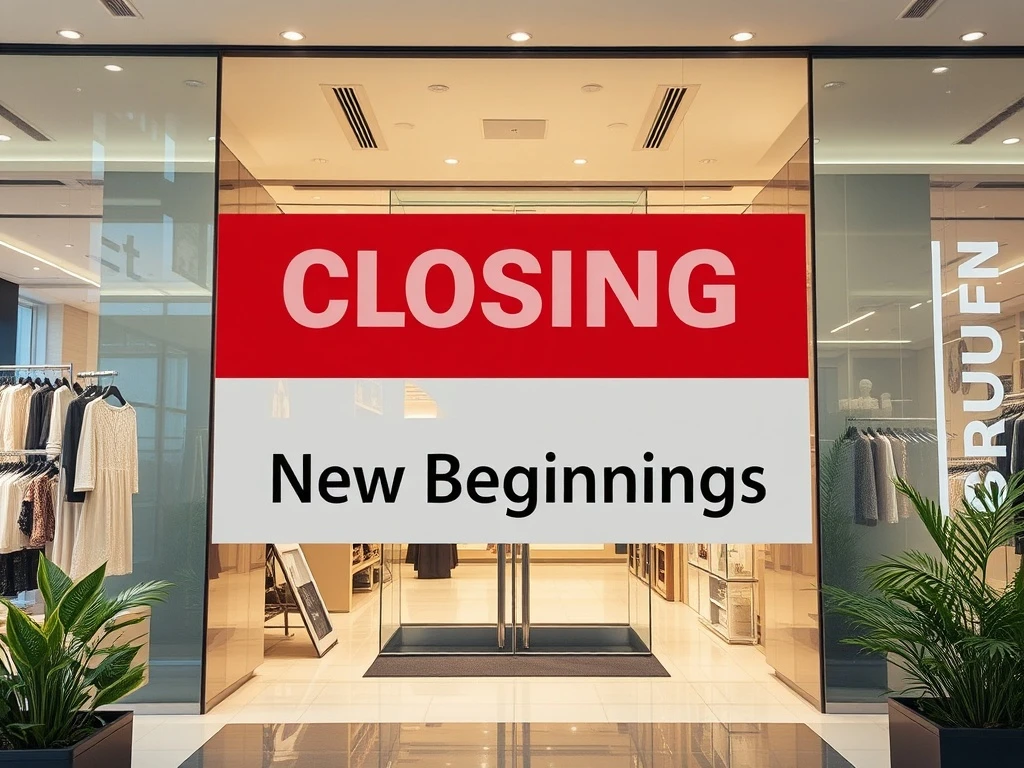The global retail landscape continues its rapid transformation. News of a famous fashion retail chain announcing **retail store closures** for 500 locations has sent ripples through the industry. This significant development, however, is not a sign of financial distress. Instead, the company firmly confirms it is *not* filing for bankruptcy. This strategic decision highlights a major shift in its long-term business model, aiming for enhanced agility and profitability in a dynamic market.
Understanding the Scope of These Retail Store Closures
The company’s announcement details an extensive plan. It involves closing approximately 500 physical stores. This represents a substantial portion of the chain’s overall physical footprint. Importantly, the fashion giant emphasized its robust financial position. They clarified that these **retail store closures** are part of a proactive, well-thought-out strategy. The primary aim is to optimize operational efficiency and enhance overall profitability. Therefore, this move is a calculated business adjustment, designed to secure future growth.
This strategic realignment will impact various regions. Furthermore, it reflects a broader industry trend. Many established retailers are re-evaluating their physical presence. They are adapting to evolving consumer habits. The decision was not made lightly. It followed extensive market analysis and performance reviews.
Why the Sudden Shift? Analyzing the Drivers Behind Retail Store Closures
Several key factors contribute to such large-scale corporate decisions. First and foremost, consumer behavior has changed dramatically in recent years. More shoppers now prefer online platforms for their purchases. This shift impacts foot traffic in traditional brick-and-mortar stores. Consequently, the reliance on physical locations diminishes. Moreover, operating costs for physical stores continue to rise steadily. Rent, utilities, and staffing represent significant and escalating expenses. These factors directly affect profit margins.
The company aims to streamline its physical presence significantly. This allows for greater investment in crucial digital channels. They also seek to improve the customer experience across all touchpoints. This includes both online and remaining physical stores. Furthermore, the company identifies a need for greater flexibility. They want to respond quickly to market fluctuations. Therefore, these **retail store closures** enable a more adaptable operational structure.
This strategic pivot is not unique to this particular fashion chain. Many prominent retailers are currently undergoing similar transformations. They are responding to a dynamic and competitive market environment. Often, **retail store closures** precede significant digital expansion efforts. The ultimate goal remains consistent: to create a more agile, efficient, and profitable enterprise. This ensures long-term viability in a fiercely competitive sector.
The Strategic Imperative: Redefining Retail Amid Store Closures
The fashion retail chain plans to reallocate substantial resources. Investment will shift heavily towards enhancing its e-commerce capabilities. They will focus on improving the entire online shopping experience. This includes several key areas:
- Improved website functionality and user interface.
- Faster and more reliable delivery options.
- Personalized customer recommendations.
- Seamless integration of online and offline services.
Additionally, the company might explore innovative, smaller format stores. These could serve as showrooms, experience centers, or convenient pick-up points for online orders. Such locations would effectively complement the enhanced online presence. This blended, omnichannel approach is becoming increasingly common. It caters directly to modern consumer preferences for convenience and flexibility.
The decision to undertake these widespread **retail store closures** is complex. It involves meticulous market analysis and data interpretation. The company has specifically identified underperforming locations. They also considered areas with significant overlap between physical and digital customer reach. This data-driven approach guides their entire restructuring effort. Ultimately, it aims to build a stronger, more sustainable business model for the future.
Impact on Employees and Local Economies
The closure of 500 stores will, unfortunately, affect many dedicated employees. The company has publicly stated its commitment to support affected staff members. This support typically includes comprehensive severance packages and professional career counseling services. Such measures aim to ease the transition for those impacted. Local economies will also feel an impact from these closures. Shopping centers might experience reduced foot traffic initially. However, new opportunities often emerge over time. Redevelopment projects or new businesses can frequently fill vacant retail spaces. This is a common pattern observed in evolving urban and commercial landscapes.
Moreover, the company’s shift towards e-commerce may create new job roles. These roles would likely be in areas like digital marketing, logistics, and data analytics. This represents a reallocation of human capital. It aligns with the company’s future-focused strategy.
Financial Stability: No Bankruptcy Signifies Strategic Strength
It is absolutely crucial to understand the key distinction in this situation. These are emphatically not distress-driven **retail store closures**. The company maintains a strong financial standing. They possess sufficient capital and liquidity. This financial health allows them to manage operations and execute this strategic transformation effectively. Avoiding bankruptcy filings signals significant corporate strength. It demonstrates a proactive and forward-thinking management team. They are adapting strategically to profound market changes. This is a clear sign of resilience and foresight, not weakness. Their balance sheet remains healthy, providing a solid foundation for future endeavors.
This situation offers a valuable lesson for the broader business community. Companies must evolve continuously. Sticking rigidly to outdated business models can prove detrimental in the long run. The fashion retail chain is making a bold, strategic move. They are prioritizing future growth and adaptability. This involves making tough decisions today. However, these decisions are designed to pave the way for long-term success and sustained profitability. It is a fundamental strategic realignment of their entire enterprise.
The Future of Fashion Retail: A Digitally-Driven Horizon
The fashion retail sector continues its rapid and profound transformation. Digital innovation drives much of this ongoing change. Therefore, companies must fully embrace technology. They need to create seamless and integrated online and offline customer experiences. These **retail store closures** represent a strategic leap forward for the company. They are making a significant bet on a digitally-centric future. This includes various technological advancements:
- Advanced personalized marketing campaigns.
- Sophisticated data analytics for consumer insights.
- Potential integration of virtual try-on technologies.
- Enhanced supply chain efficiency through automation.
The entire retail landscape is changing at an unprecedented pace. Businesses must adapt or risk being left behind. This proactive strategy aims to position the fashion chain at the forefront of this evolution.
In conclusion, the announcement of 500 **retail store closures** by a famous fashion chain marks a pivotal moment. It is a carefully considered strategic maneuver. The company is actively adapting to new market realities and consumer demands. Crucially, they are not facing bankruptcy. Instead, they are building a more resilient, digitally-focused, and sustainable future. This bold move could set an important precedent for other retailers. It emphasizes the critical importance of agility, foresight, and continuous innovation in today’s competitive market environment.
Frequently Asked Questions (FAQs)
Q1: Why is the fashion chain closing 500 stores if it’s not bankrupt?
The **retail store closures** are part of a proactive strategic decision. The company aims to optimize its physical footprint, reduce operational costs, and reallocate resources towards its growing e-commerce division. This move is a response to changing consumer shopping habits and a focus on long-term profitability and digital growth, not financial distress.
Q2: How will these retail store closures affect employees?
The company has committed to supporting affected employees. This support typically includes severance packages and career counseling services. While specific job roles in physical stores will be impacted, the shift towards digital operations may also create new opportunities in areas like e-commerce, logistics, and digital marketing.
Q3: What does ‘no bankruptcy’ mean for the company’s financial health?
‘No bankruptcy’ signifies that the company is financially stable and solvent. It possesses sufficient capital and liquidity to manage its operations and execute this strategic transformation. These are not forced closures due to financial insolvency but rather planned adjustments to strengthen its market position and ensure future viability.
Q4: Will the fashion chain still have physical stores after these closures?
Yes, the company will retain a significant number of physical stores. The closures represent an optimization of its existing footprint, not a complete abandonment of brick-and-mortar retail. The remaining stores will likely be in key locations and may be complemented by new, smaller format stores or experience centers that integrate with their enhanced online presence.
Q5: How will consumers be impacted by these retail store closures?
Consumers may find their nearest physical store closed. However, the company is heavily investing in its e-commerce platform to provide an improved online shopping experience, including better website functionality, faster delivery, and personalized services. The goal is to offer a seamless shopping journey across digital and remaining physical channels.
Q6: What is the broader industry trend behind such retail store closures?
The trend of **retail store closures** is a widespread phenomenon across the retail sector. It is driven by the rise of e-commerce, evolving consumer preferences for omnichannel shopping, and increasing operational costs for physical retail. Many retailers are strategically reducing their physical presence to invest more in digital capabilities and create more agile business models.














